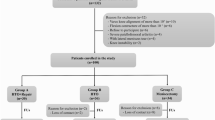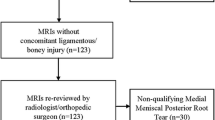Abstract
Purpose
Risk factors for meniscal tears play a decisive role in deciding on treatment and rehabilitation. The purpose of this study was to investigate the effect of tibial rotation on medial meniscus posterior horn tears (MMPHTs).
Methods
This study is a retrospective case–control study. Fifty patients with meniscal tears and 57 knees with intact meniscus were compared. Tibial rotation, femoral version, tibial slope and knee varus were measured in each participant. Knee osteoarthritis was classified according to the Kellgren–Lawrence classification. Demographic characteristics were noted.
Results
There were significant differences in the mean tibial torsion angles and mean mechanical axes between the groups. The mean tibial rotation and mean mechanical axis were 26.3° ± 6.7 and 3.7° ± 2.7 in the MMPHT group and 30.3° ± 8.4 and 2.05° ± 2.7 in the control group, respectively (p = 0.008, p = 0.002).
Conclusion
The current retrospective study has shown that tibial rotation is markedly reduced in patients with MMPHTs. Although the actual mechanism is not clear, the internal torsion of the tibia causes a decrease in the foot progression angle and increases the knee adduction moment, which in turn increases the medial tibial contact pressure. Internal torsion of the tibia, such as knee varus, may play a role in the aetiology of MMPHTs by this way. Whilst there was a significant difference in the mean varus and tibial torsion between the groups, there was no significant difference in the mean femoral version or tibial slope.
Level of evidence
III.


Similar content being viewed by others
References
Andrews M, Noyes FR, Hewett TE, Andriacchi TP (1996) Lower limb alignment and foot angle are related to stance phase knee adduction in normal subjects: a critical analysis of the reliability of gait analysis data. J Orthop Res 14:289–295
Badlani JT, Borrero C, Golla S, Harner CD, Irrgang JJ (2013) The effects of meniscus injury on the development of knee osteoarthritis: data from the osteoarthritis initiative. Am J Sports Med 41:1238–1244
Bansal S, Miller LM, Patel JM, Meadows KD, Eby MR, Saleh KS et al (2020) Transection of the medial meniscus anterior horn results in cartilage degeneration and meniscus remodeling in a large animal model. J Orthop Res 38:2696–2708
Brazier J, Migaud H, Gougeon F, Cotten A, Fontaine C, Duquennoy A (1996) Evaluation of methods for radiographic measurement of the tibial slope. A study of 83 healthy knees. Rev Chir Orthop Reparatrice Appar Mot 82:195–200
Cho S-D, Youm Y-S, Kim J-H, Cho H-Y, Kim K-H (2016) Patterns and influencing factors of medial meniscus tears in varus knee osteoarthritis. Knee Surg Relat Res 28:142. https://doi.org/10.5792/kssr.2016.28.2.142
Dean RS, DePhillipo NN, Chahla J, Larson CM, LaPrade RF (2021) Posterior tibial slope measurements using the anatomic axis are significantly increased compared with those that use the mechanical axis. Arthroscopy 37:243–249
Dong Y, Hu G, Dong Y, Hu Y, Xu Q (2014) The effect of meniscal tears and resultant partial meniscectomies on the knee contact stresses: a finite element analysis. Comput Methods Biomech Biomed Engin 17:1452–1463
Englund M, Guermazi A, Gale D, Hunter DJ, Aliabadi P, Clancy M et al (2008) Incidental meniscal findings on knee MRI in middle-aged and elderly persons. N Engl J Med 359:1108–1115
Englund M, Roemer FW, Hayashi D, Crema MD, Guermazi A (2012) Meniscus pathology, osteoarthritis and the treatment controversy. Nat Rev Rheum 8:412
Ercin E, Kaya I, Sungur I, Demirbas E, Ugras AA, Cetinus EM (2012) History, clinical findings, magnetic resonance imaging, and arthroscopic correlation in meniscal lesions. Knee Surg Sports Traumatol Arthrosc 20:851–856
Foreman SC, Liu Y, Nevitt MC, Neumann J, Joseph GB, Lane NE et al (2021) Meniscal root tears and extrusion are significantly associated with the development of accelerated knee osteoarthritis: data from the osteoarthritis initiative. Cartilage 13:239S-248S
Gelber PE, Barenius B, Perelli S (2020) Role of alignment and osteotomy in meniscal injuries. Clin Sports Med 39:211–221
Hiranaka T, Furumatsu T, Okazaki Y, Yamawaki T, Okazaki Y, Kodama Y et al (2021) Steep medial tibial slope and prolonged delay to surgery are associated with bilateral medial meniscus posterior root tear. Knee Surg Sports Traumatol Arthrosc 29:1052–1057
Hwang B-Y, Kim S-J, Lee S-W, Lee H-E, Lee C-K, Hunter DJ et al (2012) Risk factors for medial meniscus posterior root tear. Am J Sports Med 40:1606–1610
Jiang J, Liu Z, Wang X, Xia Y, Wu M (2022) Increased posterior tibial slope and meniscal slope could be risk factors for meniscal injuries: a systematic review. Arthroscopy 38:2331–2341
Kaiser P, Loth F, Attal R, Kummann M, Schuster P, Riechelmann F et al (2020) Static patella tilt and axial engagement in knee extension are mainly influenced by knee torsion, the tibial tubercle–trochlear groove distance (TTTG), and trochlear dysplasia but not by femoral or tibial torsion. Knee Surg Sports Traumatol Arthrosc 28:952–959
Kenawey M, Liodakis E, Krettek C, Ostermeier S, Horn T, Hankemeier S (2011) Effect of the lower limb rotational alignment on tibiofemoral contact pressure. Knee Surg Sports Traumatol Arthrosc 19:1851
Kim Y-M, Joo Y-B, Cha S-M, Hwang J-M (2012) Role of the mechanical axis of lower limb and body weight in the horizontal tear and root ligament tear of the posterior horn of the medial meniscus. Int Orthop 36:1849–1855
MacDessi SJ, Griffiths-Jones W, Harris IA, Bellemans J, Chen DB (2021) Coronal plane alignment of the knee (CPAK) classification: a new system for describing knee phenotypes. Bone Jt J 103:329–337
Moon H-S, Choi C-H, Jung M, Lee D-Y, Eum K-S, Kim S-H (2020) Medial meniscal posterior horn tears are associated with increased posterior tibial slope: a case-control study. Am J Sports Med 48:1702–1710
Noonan B, Cooper T, Chau M, Albersheim M, Arendt EA, Tompkins M (2022) Rotational deformity—when and how to address femoral anteversion and tibial torsion. Clin Sports Med 41:27–46
Okazaki Y, Furumatsu T, Kodama Y, Kamatsuki Y, Okazaki Y, Hiranaka T et al (2019) Steep posterior slope and shallow concave shape of the medial tibial plateau are risk factors for medial meniscus posterior root tears. Knee Surg Sports Traumatol Arthrosc 29:44–50
Schiphof D, Boers M, Bierma-Zeinstra SM (2008) Differences in descriptions of Kellgren and Lawrence grades of knee osteoarthritis. Ann Rheum Dis 67:1034–1036
Schipplein O, Andriacchi T (1991) Interaction between active and passive knee stabilizers during level walking. J Orthop Res 9:113–119
Turner MS (1994) The association between tibial torsion and knee joint pathology. Clin Orthop Relat Res 302:47–51
Wang X, Jing L, Wang X, Li Z, Li Z, Zhang Z et al (2020) Effects of medial meniscal slope and medial posterior tibial slope on the locations of meniscal tears: a retrospective observational study. Medicine 99:23351–23362
Willinger L, Foehr P, Achtnich A, Forkel P, Voss A, Liska F et al (2019) Effect of lower limb alignment in medial meniscus–deficient knees on Tibiofemoral contact pressure. Orthop J Sports Med 7:2325967118824611
Willinger L, Lang JJ, von Deimling C, Diermeier T, Petersen W, Imhoff AB et al (2020) Varus alignment increases medial meniscus extrusion and peak contact pressure: a biomechanical study. Knee Surg Sports Traumatol Arthrosc 28:1092–1098
Yagi T, Sasaki T (1986) Tibial torsion in patients with medial-type osteoarthritic knee. Clin Orthop Relat Res 213:177–182
Yazdi H, Mallakzadeh M, Farshidfar SS, Givehchian B, Daneshparvar H, Behensky H (2016) The effect of tibial rotation on knee medial and lateral compartment contact pressure. Knee Surg Sports Traumatol Arthrosc 24:79–83
Funding
Each author certifies that he or she has no financial or nonfinancial interests. This research did not receive any specific grant from funding agencies in the public, commercial, or not-for-profit sectors.
Author information
Authors and Affiliations
Contributions
EB designed the study and wrote the paper. NS edited the manuscript. MK participated in the design of the study. CY collected the data. MA analysed the data. IY made measurements. EC helped design and coordination. All authors read and approved the final manuscript. The article contains 2073 words when the references and abstract are excluded.
Corresponding author
Ethics declarations
Conflict of interest
That might pose a conflict of interest in connexion with the submitted article.
Ethical approval
This study was approved by Istınye University Ethical Committee with number 2/2021. K-77.
Additional information
Publisher's Note
Springer Nature remains neutral with regard to jurisdictional claims in published maps and institutional affiliations.
Rights and permissions
Springer Nature or its licensor holds exclusive rights to this article under a publishing agreement with the author(s) or other rightsholder(s); author self-archiving of the accepted manuscript version of this article is solely governed by the terms of such publishing agreement and applicable law.
About this article
Cite this article
Bayram, E., Şener, N., Korkmaz, M. et al. Internal tibial torsion is associated with medial meniscus posterior horn tears. Knee Surg Sports Traumatol Arthrosc 31, 2251–2256 (2023). https://doi.org/10.1007/s00167-022-07173-2
Received:
Accepted:
Published:
Issue Date:
DOI: https://doi.org/10.1007/s00167-022-07173-2




